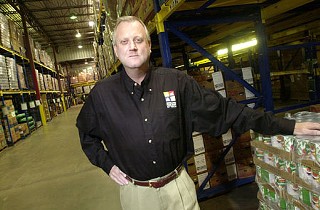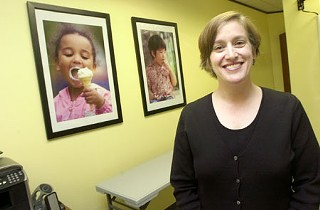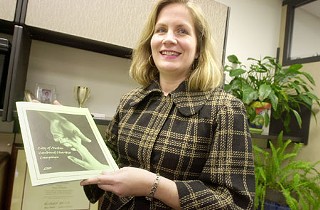Hard Times in the Land of Plenty
Service nonprofits and their funders face the economic gale
By Richard Whittaker, Fri., Oct. 23, 2009
It's another busy day at the Capital Area Food Bank of Texas.
In the sorting room at the 20,000-square-foot warehouse on South Congress, a crowd of volunteers is rooting through boxes of donated food; separating the good from the bad, the edible from the spoiled; and then stacking the results into recycled banana crates. Forklifts carry pallets of boxes and load them on trucks. Soon those meals and ingredients will be delivered to more than 350 partner agencies, food pantries, and meal providers across the charity's 21-county service area. Food bank CEO David Davenport has never seen a year like this one. He said: "Last month was the largest month for food distribution in our 28-year history. I've said that about seven or eight times in the last 12 months."
The pressure is undeniable. Last year, the food bank distributed 17 tons of food to its partner agencies. In turn, the agencies passed that food on to about 300,000 people. As of the end of September, the figure was already 22 tons, and it's expected to reach 25 tons by the end of the year. The warehouse normally holds a full month of food: Now, with increased demand, that reserve is closer to 27 days. If demand keeps up, Davenport said, "We could be in a situation, like at the beginning of [Hurricane] Ike, where there's no food out there."

– David Davenport, Capital Area Food Bank of Texas CEO (Photo by John Anderson)
The equation is simple. As the Central Texas economy gets worse, more Central Texans are turning to charities for basic assistance. Even before the economy collapsed, the pressures on the food bank and its partner agencies were extraordinary. According to the most recent study by the national food-bank network Feeding America, between 2005 and 2007 Texas led the nation in childhood "food insecurity" – meaning 22 percent of residents under 18 were either going hungry or at risk of hunger. That situation is getting worse. In 2008, the Capital Area Food Bank spent $2 million on purchased food. The current estimate is to spend the same amount this year, but Davenport fears that could rise to $4 million with surprisingly little change in the economy. He explained: "Stop looking at Austin. ... When you get into rural communities and small- and medium-sized towns – the Temples, the Killeens – you see very different impacts from the recession. Some areas are just flat-out devastated."
It's not just the recession: The drought has also taken a butcher's blade to farmers' livelihoods, while military communities like Fort Hood are overstretched by two wars. The food bank's vice president for communications, Kerri Qunell, explained, "Over the last year, the need for emergency food assistance has risen more than 60 percent across our service district." And it's not just the rural areas, she added. "Some of our agencies in Austin have seen a 300 percent increase in demand."
When it comes to fundraising, Davenport told his board at a recent presentation, "Flat is the new up." About 80 percent of the bank's revenue comes from private contributions, and while the number of small donors is up, the average donation size is down or has changed from cash to food. While food drives are a major part of the supply equation, most of what goes through the warehouse is either bought from or donated by wholesalers and the U.S. Department of Agriculture. Almost half is fresh food from the Central Texas Food Rescue program, through which firms such as H-E-B, Whole Foods, Central Market, and Wal-Mart donate short-dated perishables like vegetables and dairy, so the most needy get the nutrition they really need. Qunell said, "When you think about it, the people who are in line at the food pantry are already buying the cheap food, so we have to get them something that's nutritious and healthy." The rescue program alone has increased 600 percent over the last year, but Qunell fears for its sustainability, especially if donors have to improve their stock management during the recession. She said, "For now, we're very fortunate for what we get, but we can't expect to rely on this."
The challenge now is to distribute the food as efficiently as possible. By implementing online ordering, cutting waste, and using the same tracking system as UPS, the food bank cut shipping costs from 43 cents to 33 cents a pound. Yet the total burden changes and rises. Previously, the food bank only did direct distribution in rural areas where there are no local nonprofits; this year, it stepped in to keep open two urban food pantries – the Reaching Out Center in Pflugerville and the former Church Food Pantry, which is now the Capital Area Food Bank East Austin Service Center. For Davenport, the experience of dealing directly with famished clients means "seeing hunger through a different set of eyes." He explained: "Having a conversation with someone who hasn't eaten in four or five days, it's a difficult task to get their attention and find out what they need. Hunger does hideous things to body and mind."

For now, he said, "The challenge isn't in pushing out 2.2 million pounds of food in a month; the challenge is in replacing it." He added: "A lot of times, I come to work on Monday morning not knowing the answers for what we're going to be doing on Friday. But I'll take those questions home and come back with an answer."
Fire Season
That's an experience shared by Diane Ventresca of the American Red Cross of Central Texas. Her business card may say director of development and communications, but she's filling in as head for three departments: development, communications, and volunteers. The agency is massively overstretched, with 17 employees and 150 volunteers covering nine counties. The one bright spot is that the charitable instinct remains strong, and the total number of small donors has stayed about the same. Individual donations account for roughly 90 percent of the agency's income, so that's the good news. The bad news is that the average donation is down 44 percent from this time last year. Ventresca said, "Two thousand donors sounds like a lot, but if they're not giving as much, that really hurts."
That's meant some extraordinary measures, even for an agency with a traditionally powerful fundraising presence. After taking a $70,000 dip into the reserves just to cover operations, for the first time ever the agency is hiring a full-time grant writer. The big push is to find new donors through outreach to previous benefactors and to establish youth clubs at schools and universities. That's been a struggle in this economy. Ventresca explained, "Those that can give are scared they are going to be affected and are holding on to it just when we need it most."
Some of the Red Cross' needs are as predictable as the seasons. One of the agency's biggest jobs is assisting families after house fires. In September, 64 Central Texans needed help from the Red Cross after being displaced by fire, and as the weather gets colder, the number is expected to rise. Ventresca said: "October is the beginning of our fire season. People are putting up Halloween lights; they're making big dinners for Thanksgiving; they're turning their heaters on." The house fires have also revealed a small but disturbing statistic about the real impact of the recession. "Before, we'd help out a family that had lost everything in a house fire; there'd be three or four family members. Now there are six or seven because people are moving in together."
Special Advocates

– Diane Ventresca, American Red Cross of Central Texas (Photo by John Anderson)
Those family stresses are also putting an extra burden on family services charities. As one of a network of more than 1,000 Court Appointed Special Advocates groups around the country, CASA of Travis County guards the well-being of kids caught up in Child Protective Services cases. Under the Texas Family Code, courts are obligated to appoint a guardian ad litem for those children. Rather than paying for state agency staff or lawyers, the courts use CASA's 400 volunteers as advocates for about 1,200 children a year. Executive Director Laura Wolf said she hasn't seen an increase in the number of cases, but "an increase in the severity and more dramatic cases of abuse. As for those parents that are trying to get their families back and want to create a good home, the challenges around finding a job and a safe, stable place to live are very real and are getting much, much harder."
CASA's funding, like that of everyone else doing this work, has taken a hit – though for a nonprofit, CASA has a very diverse revenue base. Because of its court-connected role, it receives some federal, state, and county funds; the United Way issues a grant as a partner agency, and there are also private donations and major corporate and philanthropic grants. That last component has taken the biggest dive, Wolf said: "They're still giving, but they have reduced by about 20 percent to 50 percent because of reductions in their own portfolios." The bright side, if it can be seen as such, is that more unemployed or underemployed people are volunteering. Without local residents giving up 20 hours a week, Wolf said, "we would probably only be able to serve about 20 percent of the children we serve now, because we just couldn't afford 400 paid staff."
It's a similar picture for the fundraising events. This year's annual Speak Up for Kids CASA 5K race lost several corporate sponsors from previous years, but the number of racers and individual sponsors rose. Events Manager Callie Langford said: "I've seen this across all our events. The small stuff is getting larger."
As of September, CASA staff and volunteers were only working with 79 percent of the children in Travis County Child Protective Services. That missing 21 percent frustrates Wolf. She said: "The judges want us to be on 100 percent of the cases, our board wants us to be on 100 percent of the cases, we want to be on 100 percent of the cases, but we'd have to add staff to do that. The need definitely justifies that growth, but the economy doesn't." Volunteers are great, but training them costs money, and Wolf said she is worried about what will happen if the economy picks up and they have less time, or if it gets worse and they are forced to move away to hunt for jobs. As for her employees, she said: "Our staff are carrying longer hours and more caseloads. We've got people really stressed, and that's not sustainable over the long term." The worst-case scenario, she admits, would be telling judges they could not take any new cases for a while. "That's a last resort."
Everyone Is Hurting

As hard as these conditions are for charities and the people they serve, in financial terms they're not much easier for the big donors. Few names are more synonymous with philanthropy in Texas than the Dells, and as Central Texas grant officer for the Michael & Susan Dell Foundation, Chris Busse said, "I'm really privileged to say that we'll be holding constant this year." However, that's also called for a little more flexibility, as nonprofits are less interested in money for special projects and more concerned about covering operational costs. Busse said, "Obviously, we want the guiding principles of the grant to be adhered to, but if it makes sense to wait or to ask us to help other people come to the table with funds, we're more than happy to do that if we can."
This year, he's seen more charities than ever come through the door, and from further afield. Busse said, "People in Killeen, San Antonio, Dallas, are looking for support as sources in their own community have dried up." Unfortunately for them, the foundation had to make tough decisions and refocus on its core commitments. "If you spend that money and disperse it to a hundred different things that aren't in your focus area, when a particular grantee that you've worked with for 10 years comes to you and says, 'How can you help me?,' you find yourself in the very unenviable position of saying, 'I can't.'" Tough as that may be for new applicants to hear, he said, "even people who get a 'no' from us appreciate that sense of loyalty to our existing grantees."
That overall shortfall puts even more pressure on the big charity drives, especially as the holiday giving season approaches. On the third floor of One Texas Center, there's the scent of migas and waffles: The Austin Transportation Department is holding its 15th annual Killer Breakfast as part of the city's monthlong Combined Charities Campaign. Upstairs in her office, human resources assistant director and campaign chair Karen Sharp explained, "This is the only time it's sanctioned to use city facilities for fundraising." This year, the fundraising may be more important than ever.
Founded in 1993 as the Greater Austin Charities Campaign, it's the city's biggest single charity event and one of its most efficient. Since 2004, staff has used the campaign management expertise of EarthShare Texas to keep administrative costs below 7 percent. However, it's the individual departments that do the fundraising. Through a combination of special events and payroll deductions, the end result is a sizeable donation for the 12 umbrella federations representing 500 local, national, and international charities. In 2007, the campaign raised $717,000. In 2008, the target was raised to $750,000, but, in the wake of hurricanes Gustav and Ike, city staff raised $761,000. This year, in response to advice from departments, the target fell to $700,000. That was a tough decision to make, but the only one possible. Sharp said: "We're getting general feedback from our charities that everyone is hurting, so part of our strategy this year is to make our employees understand that. We aren't giving raises, but in the charitable world, there are cuts in positions, cuts in services, and their needs are even bigger."

Even with the reduced target, Sharp said the city won't be pressuring employees facing their own hard times. "It just runs contrary to what we think the spirit of charity should mean," she said. While special events like the breakfast help raise the drive's profile, she added, "the payroll deduction is where the real giving comes from." It's here that the city hopes it can make up any shortfall, and so it's adopted some new tactics on the donation form, like allowing employees to just roll over last year's pledge. Sharp said, "Even though we've only had a small number of forms turned in, just over half have checked that box."
As Davenport told the food bank board, flat is the new up.
Terra Incognita
So how can charities weather the storm? As Busse explained, it's not just about money ("Although money is good, and we haven't had anyone turn it down") but about better management and more collaboration. For example, the Red Cross is working with Pets America to keep displaced animals with their displaced owners, while Busse said the Austin Children's Shelter is working closer with LifeWorks to build "a more seamless referral system, so the kids don't fall through the cracks." He added, "We've seen increased willingness and action around collaboration [on] a very pragmatic level." For example, the Central Texas Education Stimulus Collaborative, a partnership of private foundations and public school entities including Austin Independent School District, worked together to leverage $1 million in Target Tech in Texas Collaborative Grant money. That cash will pay for technology to assist struggling students and English language learners in making the transition to middle school. Busse said, "Two years ago I do not think that districts would have come together to agree on principles and drop key priorities."
That new spirit of partnership could also be where entities like the Austin Community Foundation play a major role. Acting as a sort of combination donor fund manager, nonprofit advisor, and matchmaker for compatible philanthropists and charities, foundation CEO Kenneth Gladish explained, "We are both a recipient and a beneficiary of philanthropy and generosity and a distributor of grants." This year it's been undertaking some new initiatives, like providing technical assistance and some matching funds for 20 small nonprofits establishing their first ever endowments. But when it comes to the basic job of funding, he said, "In 2009, we're a little bit on terra incognita – unknown territory – because just like in business or government, the economic conditions we are facing are almost altogether unprecedented in the working lives of most of the leaders in the whole charitable sector."
The big change, Gladish noted, is that more money is coming in and going straight out again, rather than rebuilding or replenishing endowments. That's troubling because those funds are already injured. Even with a conservative investment approach, mostly in mutual funds, in 2008 the Austin Community Foundation still saw unrealized losses of 20 percent, "which put us about 10 percent ahead of most of our peer group and most of our benchmarks." While the stock market recovery has restored about half of those losses, cash reserves and balances on funds are far lower than he would like, and he expects 2010 to be even tougher than 2009. He said, "If this downturn has revealed one thing, it's that one of the big tests for the next decade is to build the balance sheets."
The other challenge is to end the reliance on the same old names – the Dells, the Rathgebers, H-E-B – that have been the backbone of giving in Central Texas. He said: "Too few people are bearing too high a burden for contributions and philanthropic leadership in Central Texas, and there are lots of other capable folks who should be within the circle. It's our job to make them into passionate participants and donors and fans of these organizations. I think those organizations that are able to do that will thrive and survive, and those that won't will fail."
For Davenport over at the food bank, it also has to be about realizing that, recession or not, upturn or not, the priorities of a civilized nation remain the same. He said, "In a nation as great as the United States, in a state that has the capacity to feed the country, in an immensely resourced community like ours, hunger is just flat out unacceptable."
Got something to say on the subject? Send a letter to the editor.









